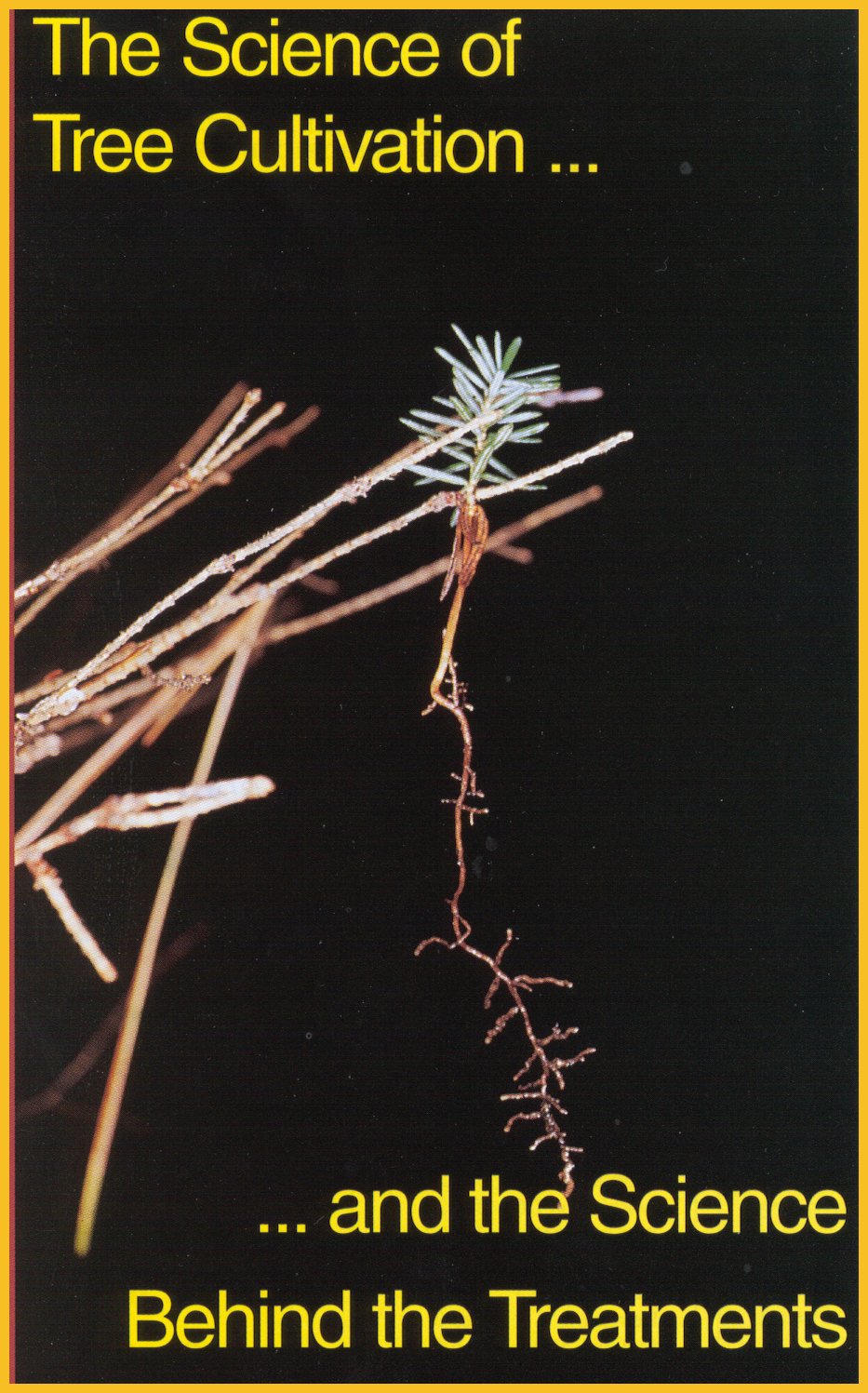 By
Dr. Alex Shigo
By
Dr. Alex Shigo
Trees in the forest start life with
their fungus friends to form mycorrhizae.
Arboriculture is a science and an art
Science is an orderly process of collecting, connecting and recording
information about natural systems. Science is understanding. Science is
mind.
Art is a process requiring skills to produce a product or performance
considered attractive or pleasing. Art is doing. Art is muscle.
Arboriculture is the cultivation of trees. To cultivate healthy,
attractive and safe trees both mind and muscle must be used. Arboriculture
is an art and a science.
Arboriculture emerged as an art
Arboriculture emerged primarily as a skill, or art form, done by strong,
working class people who were not afraid of hard work. It is time now to
add science to the cultivation of trees.
The cell theory started biology as a science
The basic science behind all tree treatments is biology. Biology as
a science started after the acceptance of the cell theory , then next came
the germ theory and later the theory of evolution. The theory of genetics
and the clarification of DNA have advanced biology to one of the leading
disciplines of science today.
Biology is the study of living systems
Biology as a science means an understanding of the chemicals and chemistry
of life. Trees are not only living systems, but they are the most massive,
longest living and tallest living systems ever to grow on earth. They support
more communities of other living systems than any other organism. The cultivation
of such superior living systems must start with an understanding of tree
biology.
Modern Arboriculture is tree cultivation based on an understanding
of tree biology. The more you know about the way the system works, the
better you can work on it.
Trees are forgiving
Trees are the most forgiving living systems on earth. They have been
mutilated and injured by humans in countless ways, yet they continue to
grow and to provide many benefits for humans, and countless communities
of other living organisms. However, as forgiving and as superior as they
are in many ways, they do have their limits for survival.
Trees are super survivors
Survival is the ability to remain alive, often under conditions that
have the potential to kill. Trees have never moved away from their problems.
Trees have many associates and over time they have developed unsurpassed
means for cooperation with them. Trees and their associates cooperate in
synergistic ways. Synergy means that the whole is greater than the sum
of the parts. Trees have also developed in ways that do not disrupt the
law of increasing mass and energy. The law states that as mass of any system
in-creases, the amount of energy necessary to maintain order in the system
must increase at an exponential rate. Trees grow within their means. And,
unlike humans, they never question or complain. They accept and adjust.
Trees have no healing system, in the sense of restoring injured
and infected tissues. Trees are generating systems. Tree defense is centered
about boundaries that form about infections, and that resist their spread.
New tree parts are always in new spatial positions.
Humans keep putting humans at the top
Humans write books. Humans have written that humans are at the top of
the line for living systems. Humans feel they are on the top position because
humans have a large brain that can think. Humans run from danger. Humans
are regenerating systems that restore injured and infected parts back in
old spatial positions. Humans heal. Humans, at best, live about a hundred
years. Most trees are still very young at the age of one hundred. I wonder
how life forms would be ranked if trees wrote the books?
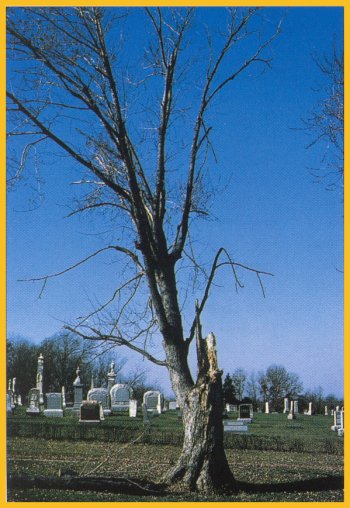 Trees are
forgiving organisms. Trees are more than big sticks of dead wood. Trees
do not heal, they compartmentalize infections. This process makes it possible
for trees to outlive humans, even when constantly mutilated.
Trees are
forgiving organisms. Trees are more than big sticks of dead wood. Trees
do not heal, they compartmentalize infections. This process makes it possible
for trees to outlive humans, even when constantly mutilated.
Humans have large brains
So, humans are supposed to be so great because of their big
brain that can think, learn, make decisions, and predict events yet to happen.
If all of this is correct, then what do trees have that make it possible for
them to far outlive humans, and still not run from fires, floods and a long list
of other destructive agents? What is the trees' secret to long success?
Trees have defense as their theme
The basic advantage trees have is that they have evolved with defense
as their theme. Their construction, physiology, chemistry, physics and
all their other properties and processes have developed with defense as
a theme. Humans have a big brain as their theme and trees have defense.
The tree "secret" is a generating system built around defense and a ready
capacity to adjust when their survival is threatened.
Defense is a dynamic survival process
Strong defense depends on a high amount of energy reserves. When enrgy
reserves are low, defense is low.
Defense is chemistry. The cell theory is about cells as the basic
unit of life. All multi-cellular organisms are made up of cells, which
are, in a sense, bags of chemicals and chemical reactions. To try to understand
biology without some understanding of chemistry is foolish. To understand
tree biology, we must start with an awareness of the simple basics of chemistry.
It is time to take the fear out of chemistry!
Learn about the principles of life
Along with chemistry, every arborist should be aware of the principles
of life. The general principles of life are true for all living things.
However, specific principles differ for each species. Defense is a general
principle, but the specific ways animals defend themselves is different
from the specific ways trees defend themselves. Another example is that
all living organisms require an energy source. This is a general principle
of life. Humans must get food already made, while trees make their own.
Trees can store energy reserves only in living cells.
Confusion of general and specific principles of life
The major problem that has followed tree cultivation from its beginning
has been the confusion of the general principles of life with the specific
principles of life for trees, or worse yet, with the specific principles
of life for humans. And, this has been so, because until very recently,
little attention was given to tree biology, and especially tree anatomy.
Anatomy must come before physiology.
Tree anatomy has been a problem because trees are so massive. Bits
and pieces of trees have been studied in the laboratory , but entire trees
have seldom been dissected. Wood anatomy is different from tree anatomy!
Wood anatomy has been studied from the view of dead prepared samples in
the laboratory. By tree anatomy, I mean entire living trees, again, entire
living trees.
Tree dissections must be done outside with large, powerful tools.
It is hard, physical work.
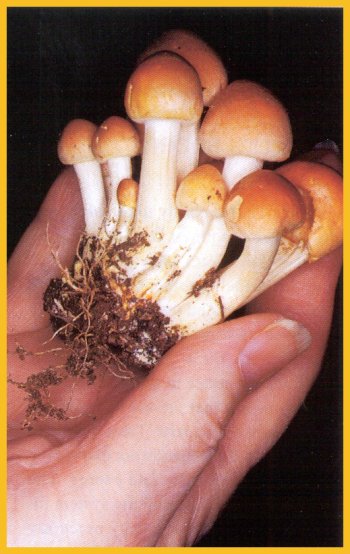 Trees connect
in synergistic ways with many other organisms. These mushrooms produce
great numbers of spores that can be blown by the wind for long distances.
When the spores germinate to form hyphae, some will infect non-woody tree
roots to form mycorrhizae.
Trees connect
in synergistic ways with many other organisms. These mushrooms produce
great numbers of spores that can be blown by the wind for long distances.
When the spores germinate to form hyphae, some will infect non-woody tree
roots to form mycorrhizae.
Separation of academics and workers
The problem is made worse because research people rarely associate with
working people. The people who have university degrees seldom go outside
to associate with tree people working in the field. (I have never been
able to convince my research colleagues that a chainsaw is a research tool!)
The separation between the working people and the university people
has existed since the beginning of science. There are many good reasons
for this, but now it is time to change this! Remember, trees are big, alive
and they do grow outside.
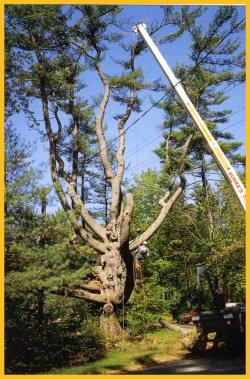 New
demands
New
demands
Science advances as new tools, new ideas, and new demands of society
connect. The people now demand tree work to be better , faster and less
expensive. The only way to meet these demands is to be able to make better
decisions faster. Better decisions faster means a better understanding
about the way tree systems function. Now we are back to science, or the
biology of trees.
Industry survival depends greatly on the rate of acceptance and
adjustment to new tools, new ideas and new demands of the market place.
The science behind the treatments
Fertilizers are chemicals. Water is a chemical. Mulch is a mass of ever-changing
chemicals. Herbicides, pesticides and all other materials used to treat
trees are chemicals. To even think about modern tree cultivation without
an understanding of chemistry is folly indeed. Pruning also depends on
an understanding of the tree system. The dose of pruning must, or should
be, based on the ratio of living cells to dead cells in a tree, the
dynamic mass to static mass ratio.
Needs for the future
There is little to be gained by dwelling on the problems of the past.
It is time to look to the future and to direct our attention to better
solutions. Here I list some ways to bring the art and science of arboriculture
to a much higher level. I remain optimistic. I know many fine arborists
who are working in these directions now. I hope that more people will join
those who are trying to accomplish these goals.
1. Establish a strong and meaningful code of ethics. Violate it and
you are out!
2. Base certification on the ability to perform at a specified high
level. Violate the rules and you are out!
3. Develop bio-profiles for the most commonly grown trees.
4. Develop levels for arboriculture based on education and abilities.
5. Establish a pre-arboriculture core education program that will
include some biology, chemistry , physics, soils, microbiology and other
natural system subjects.
6. Develop better textbooks to serve the levels of arboriculture,
and core education programs.
7. Increase the number of teachers capable of teaching biology, chemistry
and physics in arboriculture classes.
8. Have more outdoor workshops where professors and workers connect,
communicate and touch all parts of trees and soils.
9. Have more articles in trade journals written by people who are
not selling products. Reduce the number of infomercials.
10. Develop workplace education courses for people who are active,
and often very successful, in arboriculture but lack a scientific background.
Many of these people are very intelligent, but they either left school
early or were forced out of science courses because of the ways the courses
were taught. Give them another chance.
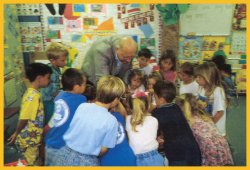 Children
are born with a natural curiosity about nature. It is our responsibility
to feed this curiosity and not to destroy it.
Children
are born with a natural curiosity about nature. It is our responsibility
to feed this curiosity and not to destroy it.
Time for modern arboriculture
Arboriculture started when honest, hard-working people went out to prune,
treat wounds and fill cavities. These three treatments have been the basic
tasks of a working tree person. Pruning was done by cutting the branch
flush to the trunk to promote "healing." Pruning wounds and other
wounds were painted to prevent rot. Cavities were cleaned and filled to
stop rot and help preserve the life of trees. Sad, but once you begin to
understand just a little tree biology, you will realize that all of the
old treatments did more harm than good. Remember, you cannot "feed" a tree,
wounds do not "heal," roots do not regenerate, wounds do not "bleed," mycorrhizae
are organs, and you cannot inoculate with organs and finally, wound dressings
do not stop decay!
Ignorance of tree biology has been, and still is, the major cause
of tree problems worldwide.
It is time for some changes. It is time for modern arboriculture.
The trees need our help now. Connect with the greatest living systems ever
to grow on earth.
Touch Trees.
“An author,
lecturer and consultant, Dr. Shigo started
Shigo and Trees, Associates
twenty
years ago after retirement from the U.S. Forest Service.”
Reproduced with permission of Tree Care Industry and Dr. Alex L.
Shigo.
The article was published in Volume XI, Number 1-January 2000 of
TCI.
This site is dedicated to the remembrance of Robert Felix who for
many years worked very hard for the improvement of the tree care industry:
1934-1996.
Back to Articles.
Dictionary MAIN
PAGE
Text & Graphics Copyright © 2008
Keslick & Son Modern Arboriculture
Please report web site problems, comments and words of interest,
not found.
Contact
 Trees are
forgiving organisms. Trees are more than big sticks of dead wood. Trees
do not heal, they compartmentalize infections. This process makes it possible
for trees to outlive humans, even when constantly mutilated.
Trees are
forgiving organisms. Trees are more than big sticks of dead wood. Trees
do not heal, they compartmentalize infections. This process makes it possible
for trees to outlive humans, even when constantly mutilated.
 By
Dr. Alex Shigo
By
Dr. Alex Shigo
 Trees are
forgiving organisms. Trees are more than big sticks of dead wood. Trees
do not heal, they compartmentalize infections. This process makes it possible
for trees to outlive humans, even when constantly mutilated.
Trees are
forgiving organisms. Trees are more than big sticks of dead wood. Trees
do not heal, they compartmentalize infections. This process makes it possible
for trees to outlive humans, even when constantly mutilated.
 Trees connect
in synergistic ways with many other organisms. These mushrooms produce
great numbers of spores that can be blown by the wind for long distances.
When the spores germinate to form hyphae, some will infect non-woody tree
roots to form mycorrhizae.
Trees connect
in synergistic ways with many other organisms. These mushrooms produce
great numbers of spores that can be blown by the wind for long distances.
When the spores germinate to form hyphae, some will infect non-woody tree
roots to form mycorrhizae.
 New
demands
New
demands Children
are born with a natural curiosity about nature. It is our responsibility
to feed this curiosity and not to destroy it.
Children
are born with a natural curiosity about nature. It is our responsibility
to feed this curiosity and not to destroy it.